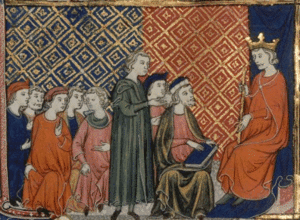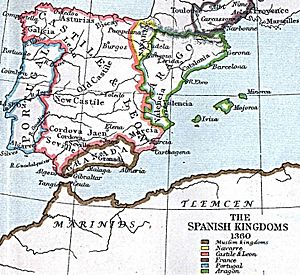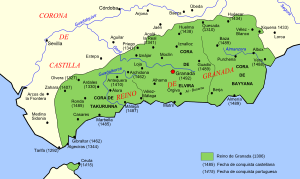Siege of Almería (1309) facts for kids
Quick facts for kids Siege of Almería |
|||||||
|---|---|---|---|---|---|---|---|
| Part of the Reconquista | |||||||
|
|||||||
| Belligerents | |||||||
| Commanders and leaders | |||||||
| Strength | |||||||
| 12,000 | Unknown | ||||||
The Siege of Almería was a battle in 1309 where the Christian kingdom of Aragon tried to capture the city of Almería from the Muslim Emirate of Granada. This event was part of the Reconquista, a long period when Christian kingdoms in Spain tried to take back land from Muslim rule.
Almería was an important port city on the Mediterranean Sea, located in the southeast of Granada. King James II of Aragon led his Aragonese troops to Almería on August 11, 1309. They surrounded the city and used large war machines to attack its walls. The city, led by Governor Abu Maydan Shuayb and naval commander Abu al-Hasan al-Randahi, had prepared well. They made their defenses stronger and stored a lot of food.
During the siege, both sides fired at each other with their war machines. There were also smaller battles and fights outside the city walls. King James II ordered several attacks, but none of them succeeded. A relief army from Granada, led by Uthman ibn Abi al-Ula, arrived in September. This army helped by attacking the Aragonese soldiers who were trying to get supplies.
As winter approached, the Aragonese army started running out of supplies. King James II agreed to a truce (a temporary stop to fighting) at the end of December. The siege was lifted, and the Aragonese began to leave Granada's lands. Since James II did not have enough ships for all his troops, some soldiers were left behind. Some of them stole from Granadan villages, and others were captured while trying to go home without permission. The Siege of Almería was a big victory for Granada. It stopped Aragon from fighting in Granada for the rest of James II's rule. Sultan Nasr of Granada made peace with Aragon and Castile in 1310.
Contents
Why Did the Siege Happen?
By the mid-1200s, the Emirate of Granada was the last Muslim kingdom left on the Iberian peninsula (modern-day Spain and Portugal). Granada managed to stay independent even though it was surrounded by two bigger neighbors: the Christian Crown of Castile to the north and the Muslim Marinid Sultanate in Morocco.
Granada often made alliances or went to war with these powers. Sometimes, it even encouraged them to fight each other. This helped Granada avoid being taken over by either side. In 1302, when Muhammad III of Granada became sultan, Granada was allied with Aragon and fighting Castile. But Muhammad III later made peace with Castile in 1303. Aragon also made peace with Castile in 1304.
Granada's Control of the Strait
With peace secured, Granada focused on North Africa. In 1306, Granada captured Ceuta, a port city across the Strait of Gibraltar. This meant Granada controlled both sides of the strait, including important ports like Gibraltar, Algeciras, Málaga, and Almería.
This made Aragon, Castile, and the Marinids very unhappy. They all started planning against Granada. Castile and Aragon signed a treaty in 1308. They promised to help each other conquer Granada and divide its lands. Aragon would get one-sixth of Granada's territory, including Almería. The rest would go to Castile.
New Alliances Against Granada
The two Christian kingdoms also made an alliance with the Marinid Sultan, Abu al-Rabi Sulayman, who wanted Ceuta back. So, Granada was now alone, surrounded by three powerful enemies.
As preparations for war began, the people of Granada became angry about their kingdom's isolation. In March 1309, they stormed the palaces of Muhammad III and his chief minister. They removed Muhammad III from power and replaced him with his younger half-brother, Nasr.
How Did They Prepare for Battle?

Granada noticed Aragon's naval preparations. In February 1309, Muhammad III asked King James II of Aragon what his navy was for. James II replied that it was for his conquest of Sardinia, not Granada.
As tensions grew, the governor of Almería, Abu Maydan Shuayb, arrested Catalan merchants in his city and took their goods. The Granadan fleet also got ready for war.
Aragon's Preparations
King James II and his ally Ferdinand IV of Castile asked Pope Clement V for help. They wanted the Pope to declare their war against Granada a "crusade" and give them money from the church. The Pope agreed. He gave James II two-thirds of the decima, which was a tax on church income. He also promised special blessings for those who joined the war.
James II gathered an army of 12,000 soldiers, including 1,000 knights and 2,000 archers. He also raised money and made the defenses of the Kingdom of Valencia stronger. Valencia was his closest territory to Granada. Almería was his main target, about 90 miles (145 km) from Granada's capital. Aragon did not share a border with Granada, so some troops traveled by sea. Others marched through Castilian lands and then through enemy territory to reach Almería.
Almería's Defenses
The city of Almería prepared for the siege by storing a lot of food and setting up a rationing system. They also strengthened the city's defenses. One Muslim account said that it was a sign of Allah's protection that there was so much barley in the storehouses when the siege began.
Governor Abu Maydan Shuayb and naval commander Abu al-Hasan al-Randahi improved the city's defenses. They made the walls stronger, closed gaps, and tore down outer buildings that the attackers might use for cover.
The Siege Begins
King James II and his forces sailed from Valencia on July 18, 1309. They landed on the coast of Almería on August 11. A Muslim writer described the Aragonese soldiers' colorful clothes and the music played by their musicians. The Aragonese army brought large siege engines, like mangonels and trebuchets, which could throw heavy rocks.
At first, this display made the defenders feel discouraged. But as time passed and different events happened, they became more hopeful.
Blocking the City
The Aragonese troops spread out to surround Almería by land and sea. They built palisades (fences of strong stakes) and dug ditches to block the city. The defenders placed archers and foot soldiers on the walls. They also blocked all the city gates with stones, except for a few that they would use for quick attacks.
The late summer arrival was a big problem for the invaders. It meant there was little time before the weather got colder. If the siege lasted into winter, it would be harder for the attackers who had to stay outside.
Granada Fights on Many Fronts
The Emirate of Granada had to defend itself from many enemies at once. In North Africa, the Marinids attacked Ceuta and took it in July. In Granada's west, Castile was besieging Algeciras and Gibraltar.
Even with these challenges, Sultan Nasr sent a relief force to Almería. However, this force was defeated by the Aragonese in a battle on August 23. A Christian report claimed the Muslims lost 6,000 men, but historians think this number is too high. Despite the defeat, the relief forces stayed nearby and kept bothering the Aragonese soldiers who were trying to find food.
Attacks on the Walls
In late August or early September, Almería's defenders fought off an attack by the Aragonese. The attackers used ladders and large siege towers filled with troops. The defenders poured boiling oil and other burning liquids on them. One siege tower was burned, and the attack failed. Many attackers were left behind and captured by the Muslims.
After this failure, the Aragonese continued to throw rocks weighing up to thirty pounds into the city. They also used sappers to dig tunnels under the city walls to make them collapse. But the defenders had their own counter-sappers who found the tunnels. There was fighting underground, and the attackers' tunnels were destroyed.
Peace with the Marinids
In mid or late September, Granada made peace with the Marinids. In exchange, Granada gave up the western towns of Algeciras and Ronda. This meant Granada had one less enemy. The Marinids also took over defending Algeciras, which freed up Nasr's forces to strengthen his eastern side.
On September 17, a group of Muslim fighters called Volunteers of the Faith arrived near Almería. They were sent from Granada under Uthman ibn Abi al-Ula. They defeated a small Aragonese force. This group camped nearby and constantly bothered the Aragonese soldiers who were looking for supplies. On October 15, the Aragonese claimed a victory against a Muslim army of 60,000, killing 2,000. Historians believe these numbers are greatly exaggerated.
A Clever Trick Fails
As the siege continued, the invaders tried a trick to fool the defenders. A group of Christian soldiers dressed in Muslim clothes and approached the city in the dark. Another group of Christian knights then pretended to chase them, leaving their tents unguarded. The tents looked like an easy target for looting, but they were actually set up for an ambush.
A group of riders came out of the city to loot the tents. But the Christians came out of their hiding spots too soon, allowing most of the riders to escape. They managed to get back into the city through a side entrance that had been opened that day. Some were left outside the walls, protected by arrows from the city. When the fighting stopped, they also re-entered the city.
Constant Bombardment
The siege was mostly about both sides firing rocks from their war machines. According to one account, 22,000 rocks were thrown during the siege. The attackers had eleven catapults or similar machines. The Muslims initially had only one, but when it was destroyed, they built three more. At the end of December, a part of the city walls was broken. The Christians rushed to attack it, but a Muslim force defended the section and stopped them from entering.
The Truce and Aragonese Retreat
By the end of the year, it was clear that Aragon was not going to win. Winter was coming, which would make it dangerous for their soldiers outside. Also, the siege of Algeciras by Castile was weakening. This allowed Granada to send more troops to fight Aragon. Strong winds from the west also stopped the Aragonese from getting supplies by sea.
The Granadan commander, Uthman ibn Abi al-Ula, not only bothered the attackers but also helped in talks with James II. At the end of December, a meeting took place in the Aragonese camp. Both sides agreed to a truce.
Leaving Granadan Lands
Under the truce, the Aragonese had to lift the siege and leave Granada's territory. It was hard to move all the troops at once because there were not enough ships. So, the evacuation happened slowly, and some men were left behind under Muslim protection.
Some discouraged Aragonese soldiers tried to go home without permission. They were ambushed and attacked along the way, and many were captured by the Muslims. At one point, Sultan Nasr wrote to James II that Almería's defenders had to hold the remaining Aragonese troops. This was because they were stealing from Granadan lands. Nasr also noted that the Muslims gave them housing and food at their own expense "because some of them were starving" while waiting for the Aragonese ships. A rumor spread in Almería that James II would attack again, but it never happened. The people of Almería removed the leftover siege works outside the city walls as a precaution. The Aragonese prisoners were later released when peace was made.
What Happened Next?
The defeat of Aragon in Almería, and Granada's defense of Algeciras against Castile, were big successes for Granada. Both Castile and Aragon made peace with Granada by early 1310.
According to historian L. P. Harvey, the humiliating defeat and evacuation of the Aragonese "taught [them] a lesson." It slowed down the progress of the reconquista for many decades. Another historian, José Ramón Hinojosa Montalvo, wrote that the "failure of the Granada enterprise" caused James II to focus his attention on the central Mediterranean Sea instead of Granada.
For Granada, the successes in Almería and Algeciras were balanced by some losses. They lost Gibraltar to Castile and gave up Algeciras and Ronda to the Marinids. Sultan Nasr himself became unpopular. He faced a rebellion from his brother-in-law Abu Said Faraj and nephew Ismail in 1311. This led to Nasr being removed from power, and Ismail became sultan in 1314.
|
See also
 In Spanish: Sitio de Almería (1309) para niños
In Spanish: Sitio de Almería (1309) para niños



